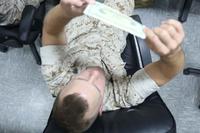China could triple its nuclear stockpile over the coming decade as it pursues more coercive and aggressive tactics in the Pacific, including outcry over a Navy ship sailing near disputed islands on Tuesday, the Defense Department predicts in a new assessment.
The annual report, released Tuesday, found that Beijing, a nuclear power since the 1960s, has now amassed more than 400 nuclear warheads but that its plans for expanding the arsenal would give it 1,500 by 2035. That building spree would give it the third-largest number of nuclear weapons among the world's nine nuclear powers, behind the U.S. and Russia.
"Current efforts exceed previous modernization attempts in both scale and complexity," according to the China Military Power Report.
Read Next: 4th Infantry Division Accidentally Tear-Gassed its Own Soldiers During Morale Event
The nuclear ambitions come as China has grown increasingly aggressive over the past two years toward Taiwan and over its disputed territorial claims in the South China Sea, the assessment also found. The latest incident on Tuesday involved the USS Chancellorsville, a guided-missile cruiser.
The Navy ship passed by the Spratly Islands near the Philippines in the South China Sea, sparking claims from China that the move was illegal. Chinese officials said they had mobilized ships and aircraft in response.
"The U.S. military's actions have seriously violated China's sovereignty and security, which is further ironclad evidence of its pursuit of navigational hegemony and militarization of the South China Sea," China spokesperson for the Southern Theater Command, Air Force Col. Tian Junli, said, according to the Associated Press.
The U.S. 7th Fleet called the statement false and "the latest in a long string of [People's Republic of China] actions to misrepresent lawful U.S. maritime operations and assert its excessive and illegitimate maritime claims."
The South China Sea is a key shipping route, especially for oil that goes to Japan, South Korea and Taiwan, which are all longtime U.S. allies. China has made claims to the region that are disputed by other nations that ring the waterway and last year created two new government districts over the Spratly and Paracel islands, and named 80 geographical features it claimed there, the Pentagon report notes.
Those claims, if accepted by the international community, would give China rights to far more of the natural resources that sit beneath the sea, including potentially massive oil reserves.
A burgeoning nuclear arsenal could complicate the strategic equation in the far Pacific in the coming years. The Pentagon report says China has increased its ability to produce and separate plutonium used in warheads by building "fast breeder" reactors and reprocessing facilities.
"If China continues the pace of its nuclear expansion, it will likely field a stockpile of about 1,500 warheads by its 2035 timeline," according to the report.
That number would put it far ahead of countries such as France, with about 290 nuclear warheads, and Pakistan, with about 165, according to stockpile figures from the Federation of American Scientists, a nonprofit policy think tank. The U.S. has about 5,428 nuclear warheads, and Russia has 5,977.
In the meantime, China is pumping money into expanding its land, air and sea nuclear delivery platforms, the report says.
China has also ratcheted up pressure -- including the use of its military -- against Taiwan. The country has been flying jets into the island country's air defense zone amid exercises practicing for an island seizure, the Defense Department reported. Taiwan is a democracy that has long been backed by the U.S., but China's communist government considers the island part of the country and expects a reunification as a key part of its national aspirations.
In August, the tensions rose to the highest point in 30 years, according to the Carnegie Endowment for International Peace, when House Speaker Nancy Pelosi visited the capital, Taipei, and met with Taiwanese officials. China launched military exercises, including firing live missiles, and cut off dialogue with the U.S. over the visit.
"The PRC could conduct a range of options for military campaigns against Taiwan, with varying degrees of feasibility and associated risks," the annual assessment says. "These options may range from an air and/or maritime blockade to a full-scale amphibious invasion to seize and occupy some of its offshore islands or all of Taiwan."
Brig. Gen. Pat Ryder, the Pentagon press secretary, called the new China report an "authoritative assessment" on the country that the department sees as its biggest national security challenge.
"The report plays a vital role in informing our understanding of our pacing challenge, and it shows again why the National Defense Strategy is laser-focused on the right issues and on the operational concepts, capabilities and resources we need today and into the future," Ryder said during a public briefing to reporters on Tuesday.
-- Travis Tritten can be reached at travis.tritten@military.com. Follow him on Twitter @Travis_Tritten.
Related: Biden: Nuclear 'Armageddon' Risk Highest Since '62 Crisis












